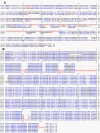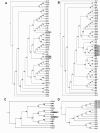Identification and characterisation of seed storage protein transcripts from Lupinus angustifolius
- PMID: 21457583
- PMCID: PMC3078879
- DOI: 10.1186/1471-2229-11-59
Identification and characterisation of seed storage protein transcripts from Lupinus angustifolius
Abstract
Background: In legumes, seed storage proteins are important for the developing seedling and are an important source of protein for humans and animals. Lupinus angustifolius (L.), also known as narrow-leaf lupin (NLL) is a grain legume crop that is gaining recognition as a potential human health food as the grain is high in protein and dietary fibre, gluten-free and low in fat and starch.
Results: Genes encoding the seed storage proteins of NLL were characterised by sequencing cDNA clones derived from developing seeds. Four families of seed storage proteins were identified and comprised three unique α, seven β, two γ and four δ conglutins. This study added eleven new expressed storage protein genes for the species. A comparison of the deduced amino acid sequences of NLL conglutins with those available for the storage proteins of Lupinus albus (L.), Pisum sativum (L.), Medicago truncatula (L.), Arachis hypogaea (L.) and Glycine max (L.) permitted the analysis of a phylogenetic relationships between proteins and demonstrated, in general, that the strongest conservation occurred within species. In the case of 7S globulin (β conglutins) and 2S sulphur-rich albumin (δ conglutins), the analysis suggests that gene duplication occurred after legume speciation. This contrasted with 11S globulin (α conglutin) and basic 7S (γ conglutin) sequences where some of these sequences appear to have diverged prior to speciation. The most abundant NLL conglutin family was β (56%), followed by α (24%), δ (15%) and γ (6%) and the transcript levels of these genes increased 103 to 106 fold during seed development. We used the 16 NLL conglutin sequences identified here to determine that for individuals specifically allergic to lupin, all seven members of the β conglutin family were potential allergens.
Conclusion: This study has characterised 16 seed storage protein genes in NLL including 11 newly-identified members. It has helped lay the foundation for efforts to use molecular breeding approaches to improve lupins, for example by reducing allergens or increasing the expression of specific seed storage protein(s) with desirable nutritional properties.
Figures






Similar articles
-
Identification of chromosome regions controlling seed storage proteins of narrow-leafed lupin (Lupinus angustifolius).J Plant Res. 2013 May;126(3):395-401. doi: 10.1007/s10265-012-0530-6. Epub 2012 Oct 23. J Plant Res. 2013. PMID: 23090157
-
Analysis of conglutin seed storage proteins across lupin species using transcriptomic, protein and comparative genomic approaches.BMC Plant Biol. 2015 Apr 19;15:106. doi: 10.1186/s12870-015-0485-6. BMC Plant Biol. 2015. PMID: 25902794 Free PMC article.
-
Characterization of narrow-leaf lupin (Lupinus angustifolius L.) recombinant major allergen IgE-binding proteins and the natural β-conglutin counterparts in sweet lupin seed species.Food Chem. 2018 Apr 1;244:60-70. doi: 10.1016/j.foodchem.2017.10.015. Epub 2017 Oct 6. Food Chem. 2018. PMID: 29120805
-
Proteomics for exploiting diversity of lupin seed storage proteins and their use as nutraceuticals for health and welfare.J Proteomics. 2016 Jun 30;143:57-68. doi: 10.1016/j.jprot.2016.03.026. Epub 2016 Mar 18. J Proteomics. 2016. PMID: 26996462 Review.
-
Nutritional composition and biological activity of narrow-leafed lupins (Lupinus angustifolius L.) hydrolysates and seeds.Food Chem. 2023 Sep 15;420:136104. doi: 10.1016/j.foodchem.2023.136104. Epub 2023 Apr 3. Food Chem. 2023. PMID: 37059020 Review.
Cited by
-
Legume Allergens Pea, Chickpea, Lentil, Lupine and Beyond.Curr Allergy Asthma Rep. 2024 Sep;24(9):527-548. doi: 10.1007/s11882-024-01165-7. Epub 2024 Jul 11. Curr Allergy Asthma Rep. 2024. PMID: 38990406 Free PMC article. Review.
-
Isolated Conglutin γ from Lupin, but not Phytate, Lowers Serum Cholesterol Without Influencing Vascular Lesion Development in the ApoE-deficient Mouse Model.Plant Foods Hum Nutr. 2015 Jun;70(2):113-8. doi: 10.1007/s11130-015-0481-x. Plant Foods Hum Nutr. 2015. PMID: 25814378
-
Identification of chromosome regions controlling seed storage proteins of narrow-leafed lupin (Lupinus angustifolius).J Plant Res. 2013 May;126(3):395-401. doi: 10.1007/s10265-012-0530-6. Epub 2012 Oct 23. J Plant Res. 2013. PMID: 23090157
-
Identification of a low digestibility δ-Conglutin in yellow lupin (Lupinus luteus L.) seed meal for atlantic salmon (Salmo salar L.) by coupling 2D-PAGE and mass spectrometry.PLoS One. 2013 Nov 22;8(11):e80369. doi: 10.1371/journal.pone.0080369. eCollection 2013. PLoS One. 2013. PMID: 24278278 Free PMC article.
-
Transcriptome sequencing of different narrow-leafed lupin tissue types provides a comprehensive uni-gene assembly and extensive gene-based molecular markers.Plant Biotechnol J. 2015 Jan;13(1):14-25. doi: 10.1111/pbi.12229. Epub 2014 Jul 24. Plant Biotechnol J. 2015. PMID: 25060816 Free PMC article.
References
-
- Johnson SK, McQuillan PL, Sin JH, Ball MJ. Sensory acceptability of white bread with added Australian sweet lupin (Lupinus angustifolius) kernel fibre and its glycaemic and insulinaemic responses when eaten as a breakfast. J Sci Food Agric. 2003;83(13):1366–1372. doi: 10.1002/jsfa.1552. - DOI
-
- French RJ, Buirchell BJ. Lupin: the largest grain legume crop in Western Australia, its adaptation and improvement through plant breeding. Australian Journal of Agricultural Research. 2005;56(11):1169–1180. doi: 10.1071/AR05088. - DOI
-
- Duranti M, Consonni A, Magni C, Sessa F, Scarafoni A. The major proteins of lupin seed: Characterisation and molecular properties for use as functional and nutraceutical ingredients. Trends in Food Science & Technology. 2008;19(12):624–633.
-
- Arnoldi A. Nutraceutical properties of white and narrow-leaved lupin. Lupins for health and wealth Proceedings of the 12th International Lupin Conference, Fremantle, Western Australia, 14-18 September 2008. 2008. pp. 452–454.
-
- Higgins TJV. Synthesis and regulation of major proteins in seeds. Annual Review of Plant Physiology and Plant Molecular Biology. 1984;35:191–221. doi: 10.1146/annurev.arplant.35.1.191. - DOI
Publication types
MeSH terms
Substances
LinkOut - more resources
Full Text Sources
Other Literature Sources

